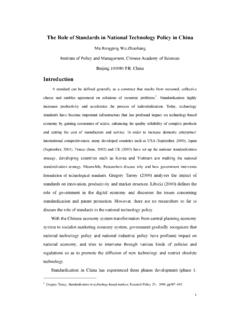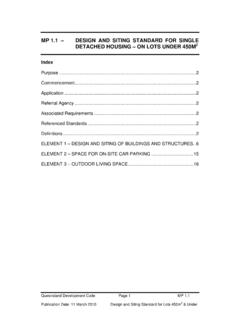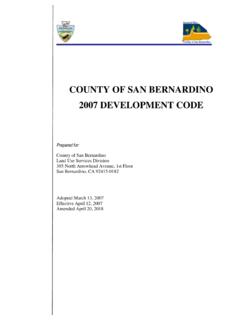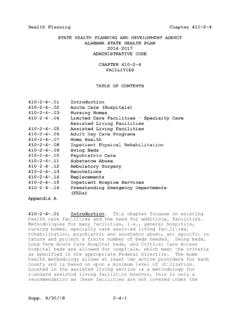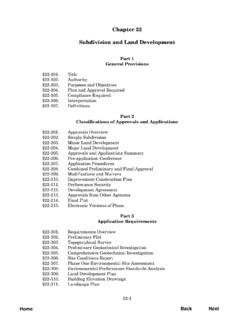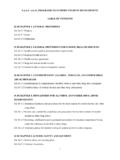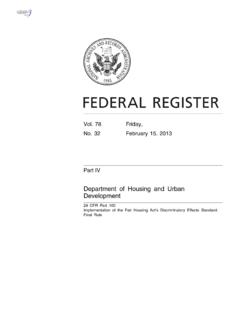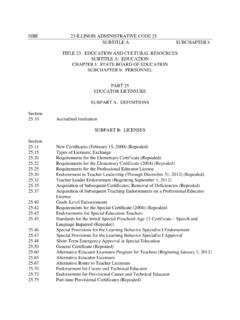Transcription of The International Building Code (IBC) - strategicstandards.com
1 The International Building code (IBC) Benjamin Trombly CMGT 564 Term Paper August 2, 2006 Table of Contents Definition 3 History 4 Structure 6 Development 8 Use in Government Regulation 10 Conclusion 12 References 13 2 Definition: A Building code is a set of rules that specify the minimum acceptable level of safety for constructed objects such as buildings. The International Building code (IBC) is a model Building code developed by the International code Council (ICC).
2 A model Building code has no legal status until it is adopted or adapted by government regulation. The IBC provides minimum standards to insure the public safety, health and welfare insofar as they are affected by Building construction and to secure safety to life and property from all hazards incident to the occupancy of buildings, structures or premises. Before the creation of the International Building code there were several different Building codes used, depending on where one decided to construct a Building . The IBC was developed to consolidate existing Building codes into one uniform code that could be used nationally and internationally to construct buildings.
3 The purpose of the IBC is to protect public health, safety and general welfare as they relate to the construction of buildings. Therefore, it is used to regulate Building construction through use of standards and is a reference for architects and engineers to use when designing buildings or Building systems. 3 History: The first Building codes can be traced back to early 1800 BC. The Babylonian emperor Hammurabi enforced what was known as the code of Hammurabi. This code was very strict and stated that, If a builder build a house for someone, and does not construct it properly, and the house which he built fall in and kill its owner, then that builder shall be put to death.
4 Building codes have evolved over time to protect the safety of Building occupants without the threat of death. Building codes were first seen in the United States in the early 1700 s AD. George Washington and Thomas Jefferson encouraged the development of Building regulations to provide minimum standards to ensure health and safety of our citizens. In the early 1900 s insurance companies lobbied for further development of Building codes to reduce properly loss payouts caused by inadequate construction standards and improperly built structures. During this time period, local code enforcement officials developed most of the Building codes with the assistance of the Building industry.
5 In 1915, the Building Officials and code Administration (BOCA) was established. This organization developed what is now known as the BOCA National Building code (BOCA/NBC), which is/was mainly used in the Northeastern United States. 4 In 1927, the International Conference of Building Officials (ICBO) was established. This organization developed what is now known as the Uniform Building code (UBC), which is/was mainly used in the Midwest and Western United States. In 1940, the Southern Building code Congress International (SBCCI) was founded. This organization developed what is now known as the Standard Building code (SBC), which is/was mainly used in the Southern United States.
6 Over the years each of these codes (BOCA/NBC, UBC, & SBC) were revised and updated. Many of the codes were duplications of one another or very similar in nature. In order to avoid duplication and to consolidate the development process BOCA, ICBO, and SBCCI formed the International code Council (ICC). The purpose of the ICC was to develop codes without regional limitations. In 1994 they began to develop what would become the International Building code (IBC). In 1997, the first edition of the IBC was published. There were still many flaws and it was not widely accepted. In 2000, the first comprehensive and coordinated set of the IBC was published.
7 All three organizations (BOCA, ICBO, & SBCCI) agreed to adopt the IBC and cease development of their respective individual codes. The IBC supercedes the BOCA/NBC, UBC, & SBC codes and states & local governments began to adopt the new consolidated code . 5 Structure: The International Building code is arranged in a systematic manner for easy reference. It incorporates all aspects of Building construction. It is made up of thirty-five (35) chapters and several appendices. The chapters in the IBC are as follows: 1) Administration 19) Concrete 2) Definitions 20) Aluminum 3) Use and Occupancy Classification 21) Masonry 4) Special Detailed Requirements Based on Use and Occupancy 22) Steel 5) General Building Heights and Areas 23) Wood 6)
8 Types of Construction 24) Glass and Glazing 7) Fire-Resistant-Rated Construction 25) Gypsum Board and Plaster 8) Interior Finishes 26) Plastic 9) Fire Protection Systems 27) Electrical 10) Means of Egress 28) Mechanical Systems 11) Accessibility 29) Plumbing Systems 12) Interior Environment 30)
9 Elevators and Conveying Systems 13) Energy Efficiency 31) Special Construction 14) Exterior Walls 32) Encroachments into the Public Right-of- 15) Roof Assemblies and Rooftop Structures Way 16) Structural Design 33) Safeguards During Construction 17) Structural Tests and Special Inspections 34) Existing Structures 18) Soils and Foundations 35) Referenced Codes Each chapter is broken down into sections and each section into sub-sections.
10 Each section describes performance criteria to be met or references other sections of the IBC or other standards such as ANSI, ASTM, etc. The following is an excerpt from Chapter 7 of IBC 2000. General. Each portion of a Building separated by one or more fire walls that comply with the provisions of this section shall be considered a separate Building . The extent and location of such fire walls shall provide a complete separation. Where a fire wall also separates groups that are required to be separated by a fire barrier wall, the most restrictive requirements of each separation shall apply. Fire walls located on property lines shall also comply with Section Such fire walls (party walls) shall be constructed without openings.
